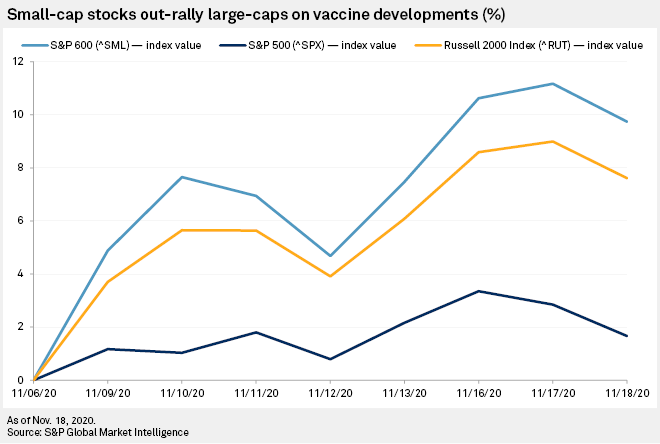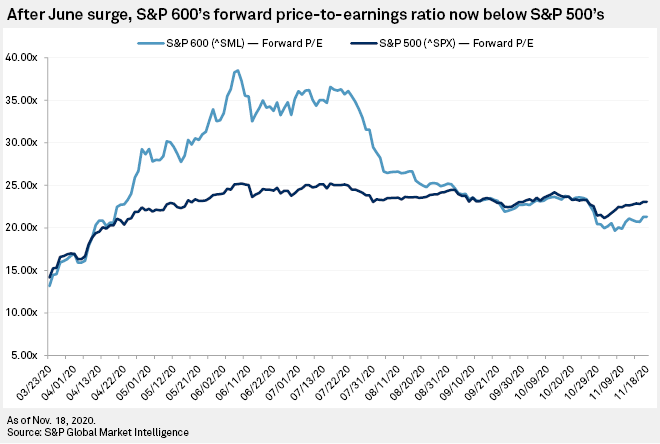U.S. small caps are having a moment.
After months of underperforming their S&P 500 peers during the pandemic, a rash of positive vaccine news and some surprisingly strong earnings have caught investors' attention.
The S&P SmallCap 600 has risen 16.6% this month through Nov. 19, beating the S&P 500's 9.5% advance. That leaves the small-cap index 71.5% higher since the market's March 23 trough, also outstripping its large-cap rival, which has gained 60.1% in that period.
The main catalyst for small caps has been announcements from Pfizer Inc., BioNTech SE and Moderna Inc. of better-than-expected efficacy rates in trials of their COVID-19 vaccines. However, the rally has also been driven by a recalibration of small-cap company performance following the biggest earnings beat in history during the third quarter, which has brought valuations down from record levels over the summer.
"I don't think this is fleeting," said Paul Schatz, president of fund manager Heritage Capital. "I think the move into small caps, into value and into the unloved. … I think it is here to stay and I think it is sustainable. I think this is a seminal change."

With the first vaccine shots potentially ready to be given early in the new year, the end of the pandemic is in sight, along with the ongoing risk of lockdowns and economic harm that comes with them. Small caps, which have fewer business lines than large caps and more reliance on the health of the domestic economy, would likely get a greater lift from a potential economic recovery, Shatz said.
"Small caps are more cyclically sensitive than large caps, and it seems reasonable to infer the market is gaining greater confidence in an economic recovery," said Steve Lipper, senior investment strategist with Royce Investment Partners. "Historically, small caps rally when the economy is expanding, particularly in the early part of an economic expansion when small caps earnings growth can be very strong coming out of a recession."
A broad risk-on mentality is starting to take hold.
An American Association of Individual Investors survey for the week ended Nov. 11 showed 55.8% of members saw the stock market moving in a bullish direction over the next six months, up from the historic average of 38%, and the highest level since January 2018.
Bank of America's latest Fund Manager Survey, released Nov. 17, showed that fund managers from Nov. 6-12 had allocations to stocks at 46% overweight, nearing the 50% level which would denote "extremely bullish" levels.
'Massive' beats
"Investors are more comfortable that the global economy is going to have a sharp rebound in 2021," said Steven DeSanctis, a small and midcap strategist at Jefferies. "Small, which is more economically sensitive, just makes more sense."
Small cap stocks are also benefiting from an increase in mergers and acquisitions, with 10 deals announced in October and six so far in November, and earnings that have been beating analyst expectations at a record rate, he said.
"The beats are massive," DeSanctis said.
As of Nov. 18, about 66.5% of Russell 2000 companies had announced earnings that beat analyst expectations, an all-time high and an increase of 7.5 percentage points from the second quarter, according to DeSanctis' analysis. The spread between actual earnings and consensus expectations has averaged 35.2%, also a new all-time high and up 1.8 points from the second quarter.

Underestimation of future earnings among S&P 600 companies helped push the index's 12-month forward price-to-earnings, or P/E, ratio to a record 38.5x in early June, compared to the S&P 500’s p/e ratio, which was at 25.1x at the time.
As of Nov. 18, the S&P 600’s P/E ratio was at 21.3x, compared with the S&P 500’s 23x.
"Using the traditional forward P/E based on earnings expected over the 12-months, it suggested that stocks were richly valued," said Joseph Abbott, chief quantitative strategist with Yardeni Research. "If we ignored the dismal earnings expected in the near term [over the next six months] and instead focused on the substantially higher forward earnings ending 18 months from now, valuations were more reasonable," he said.



